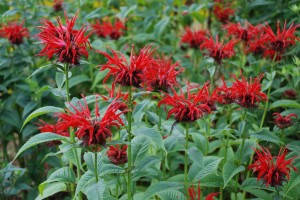Beebalm (Monarda spp.) is one of our great native perennials and herbs. Native Americans used beebalm as a tea, brewing it for colds, minor bronchial and digestive complaints, and also as a poultice to soothe insect stings. During the Boston Tea Party, rebellious colonists utilized beebalm as a tea substitute, calling it “Oswego tea”. To ward off mosquitoes and flies, people used beebalm leaves tucked under their hats.
Monarda is a member of the mint family, and edible leaves are aromatic and minty. Beebalm prefers a moist, richly organic, well-drained soil in full sun to light shade. Beebalm tolerates summer heat but not prolonged droughts. Fertilize plants in early spring and 6-8 weeks later with 10-10-10 or equivalent granular product or feed monthly through August with water-soluble fertilizers such as Miracle-Gro®, Daniels™ or Schultz™.
Beebalm grows from two to four feet tall depending on the cultivar, and will fit well into your herb or perennial garden. Bees, butterflies and hummingbirds are attracted to its colorful, nectar rich tubular flowers which open in early June in the Southern Appalachian region (USDA hardiness zones 6 and 7). Beebalm will re-bloom when the spent flowers are deadheaded.
Flower colors range from bright red, white, pink, lavender and purple. Beebalm seeds-in heavily over time, and a flower bed usually becomes overcrowded within two to three years, requiring clumps to be divided. Deadheading spent flowers stimulates re-blooming and reduces the re-seeding problem.
Beebalm has few pests – except powdery mildew, a serious foliage disease. Summer heat, high humidity, and overcrowded plants turns on powdery mildew to coat beebalm foliage white. Weekly spraying with garden fungicides from late June to frost is not a practical solution. Instead, select disease resistant varieties of beebalm.
A few of the better cultivars (M. didyma and hybrids) are:
‘Jacob Cline’ – large deep red flowers on 3-4 feet tall plants; superior mildew resistance.
‘Croftway Pink’– rose-pink flowers; not mildew resistant.
‘Marshall’s Delight’– deep pink flowers; good mildew resistance.
‘Snow Queen’– white flowers; not mildew resistant.
‘Claire Grace’ – good mildew resistance; lavender flowers on 3-4 feet tall plants (M. fistulosa).


 Posted in
Posted in 
